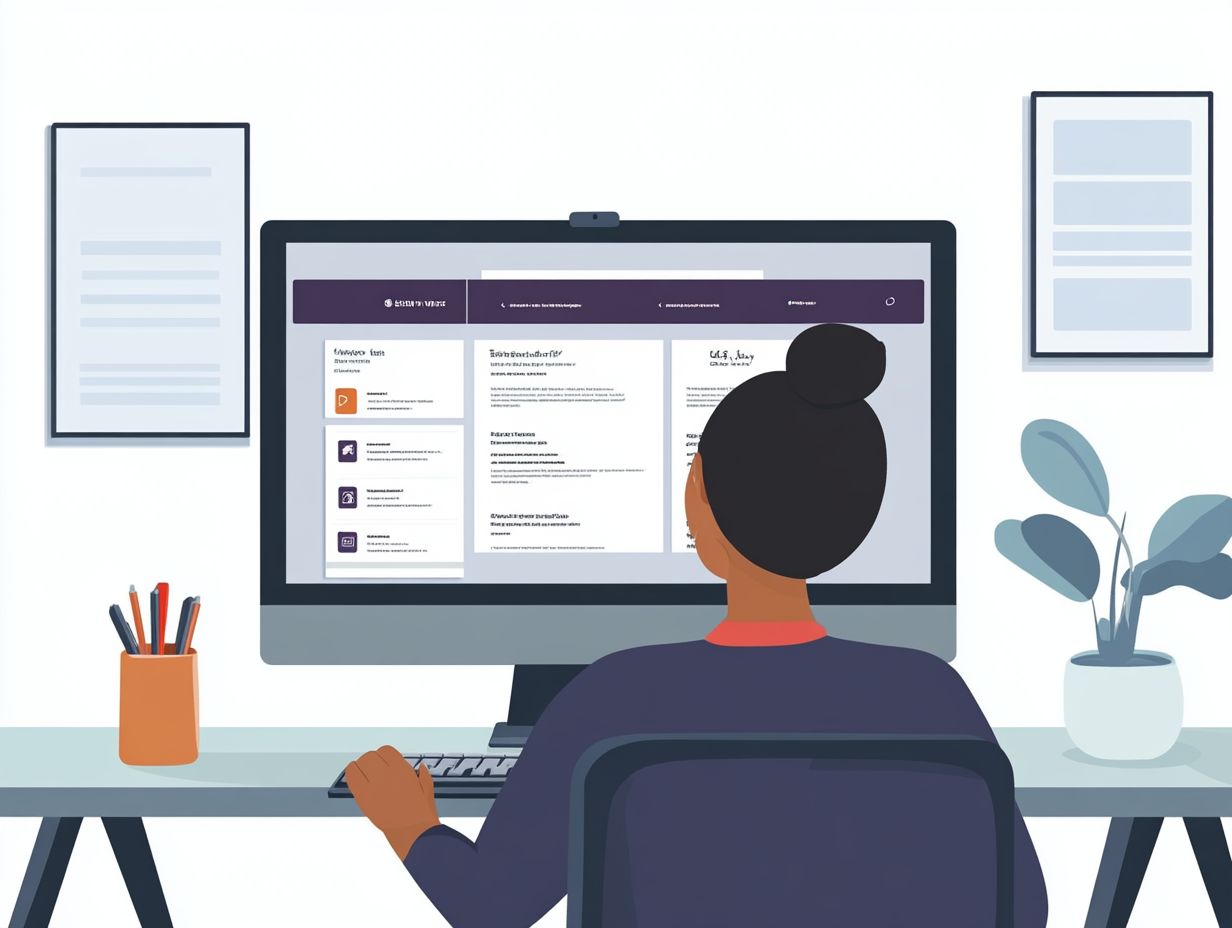How to Set Up an Onboarding Portal
In today s bustling job market, a great onboarding experience can set your new hires up for success right from the start. Creating a seamless onboarding experience is vital for both you and your new hires. An onboarding portal has the power to revolutionize how your organization welcomes and trains employees, transforming the process into an efficient and engaging journey.
This article delves into the heart of onboarding portals, highlighting their benefits and essential features that elevate the experience. You ll find guidance on setting one up, customizing it to meet your specific needs, and implementing best practices for ensuring success.
Whether you re new to the world of onboarding or seeking to refine your current process, this comprehensive guide is designed to equip you with all the insights you need.
Contents
- Key Takeaways:
- Benefits of Using an Onboarding Portal
- Setting Up an Onboarding Portal
- Key Features of an Onboarding Portal
- Best Practices for Using an Onboarding Portal
- Measuring the Success of Your Onboarding Portal
- Frequently Asked Questions
- What is an Onboarding Portal and why is it important?
- How do I set up an Onboarding Portal for my company?
- Can I automate the onboarding process using an Onboarding Portal?
- Is an Onboarding Portal secure?
- Can I track the progress of new hires using an Onboarding Portal?
- Can I customize the content on the Onboarding Portal?
Key Takeaways:

- Streamline your onboarding process by using an onboarding portal, saving time and resources.
- Improve employee engagement with a personalized and interactive onboarding experience.
- Choose a platform and customize your portal to fit your company’s needs and enhance the onboarding experience.
What is an Onboarding Portal?
An onboarding portal is your all-in-one platform designed to simplify the onboarding process for new hires. It acts as a gateway, seamlessly integrating employees into the workplace by providing easy access to vital resources, including company policies, training materials, and HR documents. This digital interface ensures that your onboarding experience is not only efficient and organized but also tailored to meet the unique needs of both your organization and its newcomers.
The significance of such a portal is immense; it serves as a digital compass, guiding newcomers through the various steps of onboarding. You ll find features like interactive checklists, quick links to essential training modules, and an FAQ section that alleviates any uncertainties. This allows new hires to engage effortlessly with the onboarding software, making their transition smoother and more enjoyable.
By consolidating information and support, the portal elevates employee satisfaction and accelerates the time it takes for them to become productive members of the team. It stands as an essential tool in cultivating a positive workplace culture from day one.
Benefits of Using an Onboarding Portal
Utilizing an onboarding portal presents a wealth of advantages that truly elevate the onboarding experience for new hires, boost employee satisfaction, and streamline task management for HR teams.
By bringing together resources, tools, and important documents, you can ensure that every new employee receives the essential information and support they need during their transition period. This method enhances the experience and lays the groundwork for your organization s long-term success.
Streamlining the Onboarding Process
Streamlining your onboarding process is essential for helping new hires quickly adjust to their new jobs within your organization. By leveraging an effective onboarding system, you can implement automated reminders and workflow processes that guide employees through crucial steps, such as safety orientation and role clarification.
Using specialized onboarding software significantly enhances your task management and progress tracking, ensuring that new employees receive timely feedback and support. Integrating structured onboarding templates tailored to various roles not only sets clear expectations but also helps deliver comprehensive training modules efficiently. This approach minimizes confusion and empowers new hires to feel more confident in their positions.
Fostering a culture of continuous improvement is vital; soliciting feedback from recent hires about their onboarding experience can reveal areas for enhancement, ultimately refining the process for future newcomers.
Take the first step towards improving your onboarding process today!
Improving Employee Engagement
Improving employee engagement is crucial for cultivating a positive onboarding experience and seamlessly integrating new hires into your company culture. By incorporating interactive content and team introductions within your onboarding portal, you create a welcoming environment that fosters communication and collaboration from day one.
Utilizing onboarding software can streamline this process even further. Equip yourself with tools that enable real-time communication, such as instant messaging and feedback forums. For example, gamified learning modules captivate new employees, allowing them to explore your company s history and values in an engaging, interactive manner.
Virtual meet-and-greets with team members will make newcomers feel instantly connected! Additionally, interactive quizzes can assess their cultural understanding and ensure alignment with your company goals. By integrating these methods, you not only enrich the onboarding experience but also boost retention and productivity, ultimately strengthening the entire organization.
Setting Up an Onboarding Portal

Establishing an onboarding portal requires careful planning to ensure it effectively serves both your organization and its new recruits. Select a platform that aligns seamlessly with your company s objectives, customize the portal to embody your unique culture and values, and integrate key HR documents (like employee handbooks, which provide essential guidelines) and training materials.
This approach will pave the way for a streamlined and impactful onboarding experience.
Choosing a Platform
Choosing the right platform for your onboarding portal significantly influences the effectiveness of your onboarding process. Options like onboarding software integrated with Microsoft 365 or SharePoint provide a centralized hub for organizing and managing onboarding materials. This setup ensures that new hires enjoy a seamless experience.
In addition, you might explore dedicated onboarding solutions such as BambooHR or Workday, specifically designed to enhance the onboarding journey.
When evaluating these platforms, compare features like user-friendliness, tool integration, and their ability to scale alongside your company s growth. Also, consider customization options that enable you to tailor the portal to meet your organization s unique needs.
Finally, don t overlook the overall user experience. Ensuring that new hires feel welcomed and engaged from day one sets the tone for their entire tenure with your team.
Customizing the Portal for Your Company
Customizing the onboarding portal to reflect your company’s culture and values is essential for crafting an engaging experience for new hires. By tailoring the portal with onboarding templates, a resource library, and company-specific content, you enhance the onboarding journey and cultivate a genuine sense of belonging among employees.
Integrating elements like your company s mission statement and visuals that embody your organizational ethos allows new hires to connect with their workplace environment right from the start. For example, including interactive quizzes about company values in the onboarding template injects a dynamic twist into the process.
Additionally, a resource library featuring videos from leadership, testimonials from current employees, and links to community engagement initiatives can significantly enrich the new employee’s experience. Effectively showcasing these elements supports a smoother transition and fosters alignment with your corporate vision, leading to greater job satisfaction and improved retention rates.
Key Features of an Onboarding Portal
The key features of an onboarding portal play a crucial role in elevating the onboarding experience for both new hires and HR teams.
With effective document management, streamlined task assignments, and thorough progress tracking, you can ensure that employees remain well-informed and actively engaged throughout their onboarding journey.
Start setting up your onboarding portal today!
Document Management
Document management stands as a cornerstone of your onboarding portal, empowering your organization to efficiently organize and store compliance and HR documentation. A well-structured document management system ensures new hires can easily access the materials they need. This makes their onboarding experience smoother.
This approach not only elevates the experience for new employees but also reinforces following the law. To optimize file organization, consider categorizing documents by type, such as:
- Employee handbooks
- Tax forms
- Benefits enrollment materials
Ensuring these documents are easily searchable is essential. Compliance materials, including workplace safety policies, confidentiality agreements, and anti-discrimination laws, should be readily accessible to mitigate risks associated with non-compliance.
By employing standardized naming conventions and keeping track of different versions of documents, you can further enhance the retrieval process. This makes it easy for hiring managers and HR teams to maintain compliance while cultivating a supportive environment for new talent.
Task Assignments and Tracking

Task assignments and tracking are essential elements of an onboarding portal, offering you a clear roadmap for your onboarding journey. By implementing an onboarding checklist and automated reminders, organizations empower you to take charge of your own progress while ensuring that you complete tasks in a timely manner.
This approach makes onboarding easier and more enjoyable. You can easily identify which tasks require your immediate attention and which can be tackled later, allowing for more effective time management.
These automated reminders act as gentle nudges, encouraging you to stay on track and communicate your progress efficiently. Assigning specific responsibilities encourages responsibility, enhancing your confidence right from the start.
As a result, organizations benefit from improved retention rates and higher satisfaction levels among employees, all thanks to a thoughtfully structured system for managing tasks during onboarding.
Best Practices for Using an Onboarding Portal
Implementing best practices for your onboarding portal is crucial for maximizing its effectiveness and creating a seamless experience for new hires. This involves establishing clear and effective communication channels with your new team members, safeguarding sensitive information to maintain security and privacy, and leveraging feedback tools to continuously enhance the onboarding process.
By focusing on these elements, you can elevate the onboarding journey and set the stage for long-term success.
Communicating with New Hires
Effective communication with new hires is the cornerstone of a successful onboarding process, profoundly influencing their engagement and satisfaction. By leveraging the onboarding portal to send welcome messages, share organizational updates, and clearly outline expectations, HR teams can cultivate a welcome atmosphere that resonates with the company culture.
Beyond those initial interactions, employing a variety of communication strategies through the portal can elevate the overall experience. Features like interactive FAQs, video introductions, and team meet-and-greets help new hires feel connected and well-informed from day one. Regular updates, whether through newsletters or status checks, keep them engaged and address any lingering questions.
By ensuring consistent communication and providing accessible resources, organizations can foster an environment that nurtures confidence and a sense of belonging. Consistent communication is vital. It builds confidence and belonging, key for retaining talent.
Ensuring Security and Privacy
Ensuring security and privacy within the onboarding portal is crucial for protecting sensitive information and maintaining compliance with organizational policies and regulations. Implement robust security measures and regularly update compliance documentation to safeguard data and provide new hires with peace of mind.
To strengthen the onboarding process, incorporate multi-factor authentication a way to make sure users are who they say they are by requiring additional verification rules for creating strong passwords, and data encryption. Regular audits should assess the effectiveness of these security protocols. Training staff on best practices can significantly mitigate the risk of human error.
Keeping compliance documentation up-to-date showcases your commitment to security and ensures adherence to evolving industry standards. Prioritizing these measures creates a safe environment for sensitive data during onboarding.
Measuring the Success of Your Onboarding Portal
Measuring the success of your onboarding portal is essential to improve the experience for new hires! By meticulously tracking various metrics such as employee satisfaction and performance reviews you can garner valuable insights into the onboarding experience.
This approach gives you the power to make informed, data-driven decisions that elevate the entire process.
Metrics to Track

Tracking specific metrics is essential for evaluating the success of your onboarding portal and grasping its impact on the overall onboarding experience. Consider key metrics such as employee satisfaction scores, the completion rate of onboarding tasks, and the issuance of completion certificates.
Monitoring engagement levels during training sessions is also important. Gather feedback on individual modules and track the time taken to complete each phase of the onboarding process.
By analyzing these metrics, you can pinpoint potential bottlenecks, identify areas of the portal that require improvement, and recognize trends that correlate with higher satisfaction levels. This data-driven approach refines the onboarding experience and enhances retention rates, boosting overall employee morale and fostering a more welcoming environment for new hires.
Frequently Asked Questions
What is an Onboarding Portal and why is it important?
An Onboarding Portal is a digital tool that makes the onboarding process smoother. It helps new hires access important documents, complete forms, and learn about the company culture quickly. It is important because it saves time and effort for both the company and the new employee, ensures a consistent onboarding experience, and sets the tone for a positive work relationship.
How do I set up an Onboarding Portal for my company?
The first step is to choose an Onboarding Portal software that meets your company’s needs. Then, customize the portal with your company branding and set up user roles and permissions. Next, create and upload all necessary documents and forms for new hires to complete. Finally, communicate the portal to new hires and provide them with login instructions.
Can I automate the onboarding process using an Onboarding Portal?
Yes! One of the main benefits of an Onboarding Portal is its ability to automate the onboarding process. You can set up workflows and notifications to guide new hires through the necessary steps and keep track of their progress. This saves time and eliminates the risk of important steps being missed.
Is an Onboarding Portal secure?
Yes, most Onboarding Portals have advanced security measures in place to protect sensitive employee information. This includes password protection, encryption, and secure data storage. You can also set up user permissions to restrict access to certain documents and forms.
Can I track the progress of new hires using an Onboarding Portal?
Yes! Onboarding Portals typically have tracking and reporting capabilities that allow you to monitor the progress of each new hire. This helps you identify any delays or issues in the process and make necessary adjustments.
Can I customize the content on the Onboarding Portal?
Absolutely! Take charge of your Onboarding Portal and tailor it to your needs. Add or remove documents, forms, and videos today!
Plus, customize the layout and design for a look that boldly reflects your company s unique style and culture!






